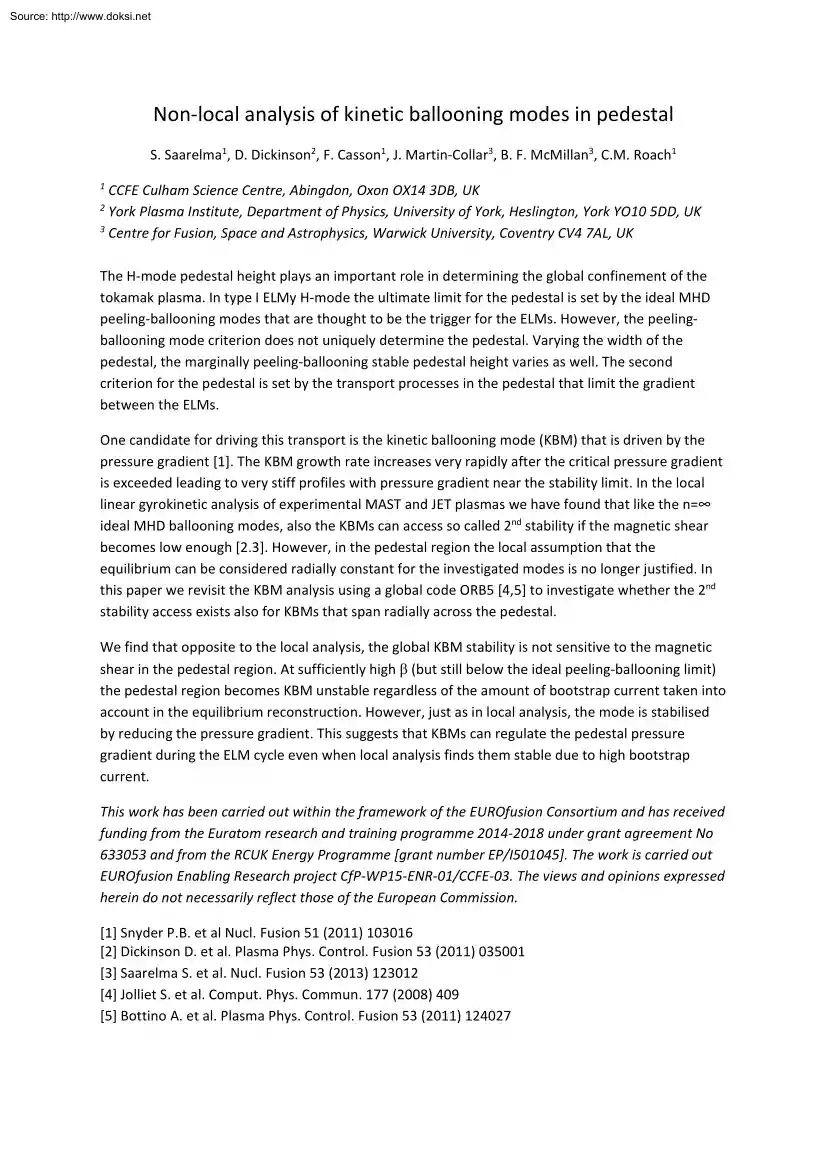Datasheet
Year, pagecount:2016, 1 page(s)
Language:English
Downloads:2
Uploaded:August 08, 2018
Size:535 KB
Institution:
-
Comments:
Attachment:-
Download in PDF:Please log in!
Comments
No comments yet. You can be the first!
Most popular documents in this category
Content extract
Source: http://www.doksinet Non‐local analysis of kinetic ballooning modes in pedestal S. Saarelma1, D Dickinson2, F Casson1, J Martin‐Collar3, B F McMillan3, CM Roach1 1 CCFE Culham Science Centre, Abingdon, Oxon OX14 3DB, UK York Plasma Institute, Department of Physics, University of York, Heslington, York YO10 5DD, UK 3 Centre for Fusion, Space and Astrophysics, Warwick University, Coventry CV4 7AL, UK 2 The H‐mode pedestal height plays an important role in determining the global confinement of the tokamak plasma. In type I ELMy H‐mode the ultimate limit for the pedestal is set by the ideal MHD peeling‐ballooning modes that are thought to be the trigger for the ELMs. However, the peeling‐ ballooning mode criterion does not uniquely determine the pedestal. Varying the width of the pedestal, the marginally peeling‐ballooning stable pedestal height varies as well. The second criterion for the pedestal is set by the transport processes in the pedestal that limit the
gradient between the ELMs. One candidate for driving this transport is the kinetic ballooning mode (KBM) that is driven by the pressure gradient [1]. The KBM growth rate increases very rapidly after the critical pressure gradient is exceeded leading to very stiff profiles with pressure gradient near the stability limit. In the local linear gyrokinetic analysis of experimental MAST and JET plasmas we have found that like the n=∞ ideal MHD ballooning modes, also the KBMs can access so called 2nd stability if the magnetic shear becomes low enough [2.3] However, in the pedestal region the local assumption that the equilibrium can be considered radially constant for the investigated modes is no longer justified. In this paper we revisit the KBM analysis using a global code ORB5 [4,5] to investigate whether the 2nd stability access exists also for KBMs that span radially across the pedestal. We find that opposite to the local analysis, the global KBM stability is not sensitive to the
magnetic shear in the pedestal region. At sufficiently high (but still below the ideal peeling‐ballooning limit) the pedestal region becomes KBM unstable regardless of the amount of bootstrap current taken into account in the equilibrium reconstruction. However, just as in local analysis, the mode is stabilised by reducing the pressure gradient. This suggests that KBMs can regulate the pedestal pressure gradient during the ELM cycle even when local analysis finds them stable due to high bootstrap current. This work has been carried out within the framework of the EUROfusion Consortium and has received funding from the Euratom research and training programme 2014‐2018 under grant agreement No 633053 and from the RCUK Energy Programme [grant number EP/I501045]. The work is carried out EUROfusion Enabling Research project CfP‐WP15‐ENR‐01/CCFE‐03. The views and opinions expressed herein do not necessarily reflect those of the European Commission. [1] Snyder P.B et al Nucl
Fusion 51 (2011) 103016 [2] Dickinson D. et al Plasma Phys Control Fusion 53 (2011) 035001 [3] Saarelma S. et al Nucl Fusion 53 (2013) 123012 [4] Jolliet S. et al Comput Phys Commun 177 (2008) 409 [5] Bottino A. et al Plasma Phys Control Fusion 53 (2011) 124027
gradient between the ELMs. One candidate for driving this transport is the kinetic ballooning mode (KBM) that is driven by the pressure gradient [1]. The KBM growth rate increases very rapidly after the critical pressure gradient is exceeded leading to very stiff profiles with pressure gradient near the stability limit. In the local linear gyrokinetic analysis of experimental MAST and JET plasmas we have found that like the n=∞ ideal MHD ballooning modes, also the KBMs can access so called 2nd stability if the magnetic shear becomes low enough [2.3] However, in the pedestal region the local assumption that the equilibrium can be considered radially constant for the investigated modes is no longer justified. In this paper we revisit the KBM analysis using a global code ORB5 [4,5] to investigate whether the 2nd stability access exists also for KBMs that span radially across the pedestal. We find that opposite to the local analysis, the global KBM stability is not sensitive to the
magnetic shear in the pedestal region. At sufficiently high (but still below the ideal peeling‐ballooning limit) the pedestal region becomes KBM unstable regardless of the amount of bootstrap current taken into account in the equilibrium reconstruction. However, just as in local analysis, the mode is stabilised by reducing the pressure gradient. This suggests that KBMs can regulate the pedestal pressure gradient during the ELM cycle even when local analysis finds them stable due to high bootstrap current. This work has been carried out within the framework of the EUROfusion Consortium and has received funding from the Euratom research and training programme 2014‐2018 under grant agreement No 633053 and from the RCUK Energy Programme [grant number EP/I501045]. The work is carried out EUROfusion Enabling Research project CfP‐WP15‐ENR‐01/CCFE‐03. The views and opinions expressed herein do not necessarily reflect those of the European Commission. [1] Snyder P.B et al Nucl
Fusion 51 (2011) 103016 [2] Dickinson D. et al Plasma Phys Control Fusion 53 (2011) 035001 [3] Saarelma S. et al Nucl Fusion 53 (2013) 123012 [4] Jolliet S. et al Comput Phys Commun 177 (2008) 409 [5] Bottino A. et al Plasma Phys Control Fusion 53 (2011) 124027





 When reading, most of us just let a story wash over us, getting lost in the world of the book rather than paying attention to the individual elements of the plot or writing. However, in English class, our teachers ask us to look at the mechanics of the writing.
When reading, most of us just let a story wash over us, getting lost in the world of the book rather than paying attention to the individual elements of the plot or writing. However, in English class, our teachers ask us to look at the mechanics of the writing.